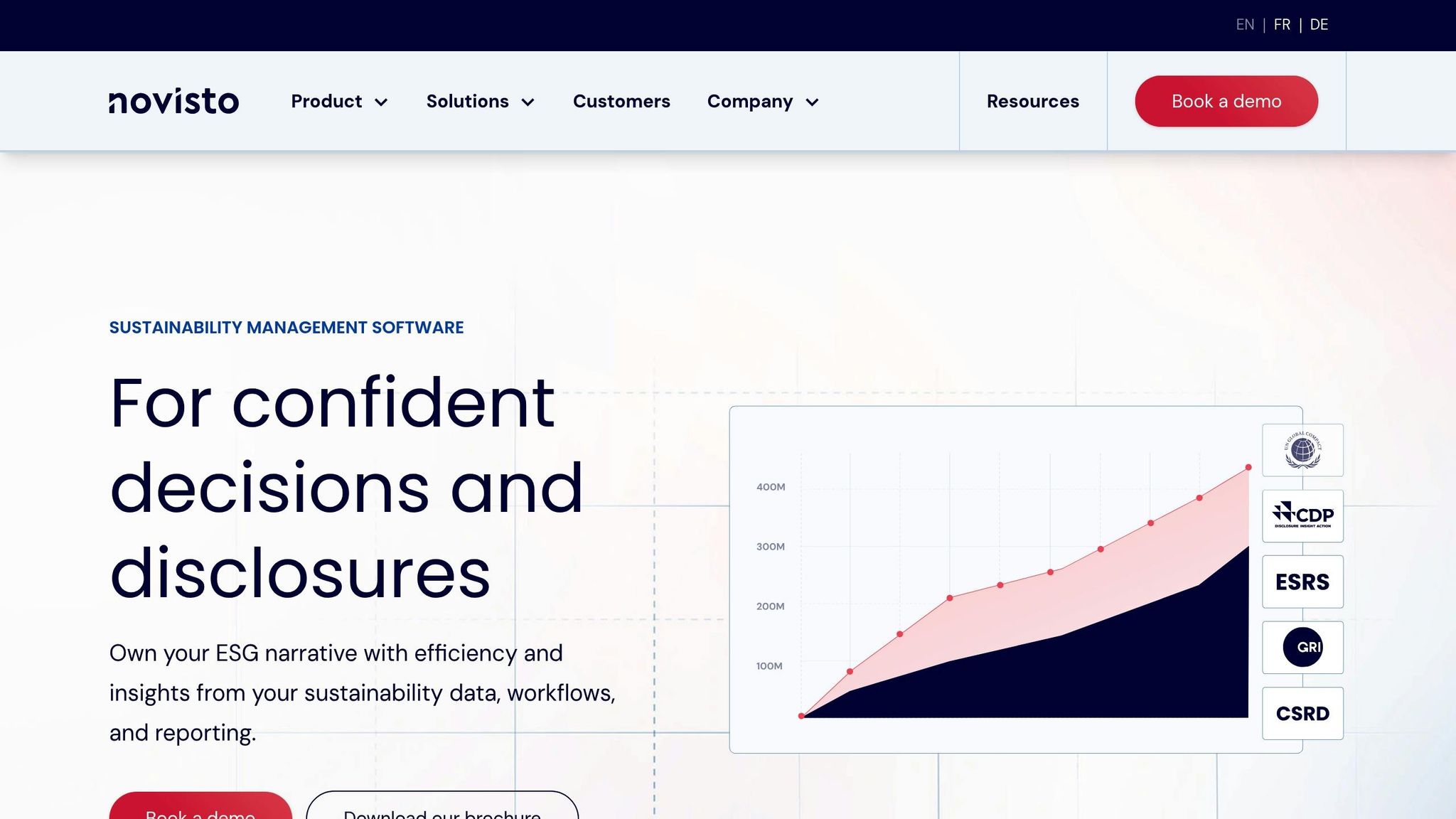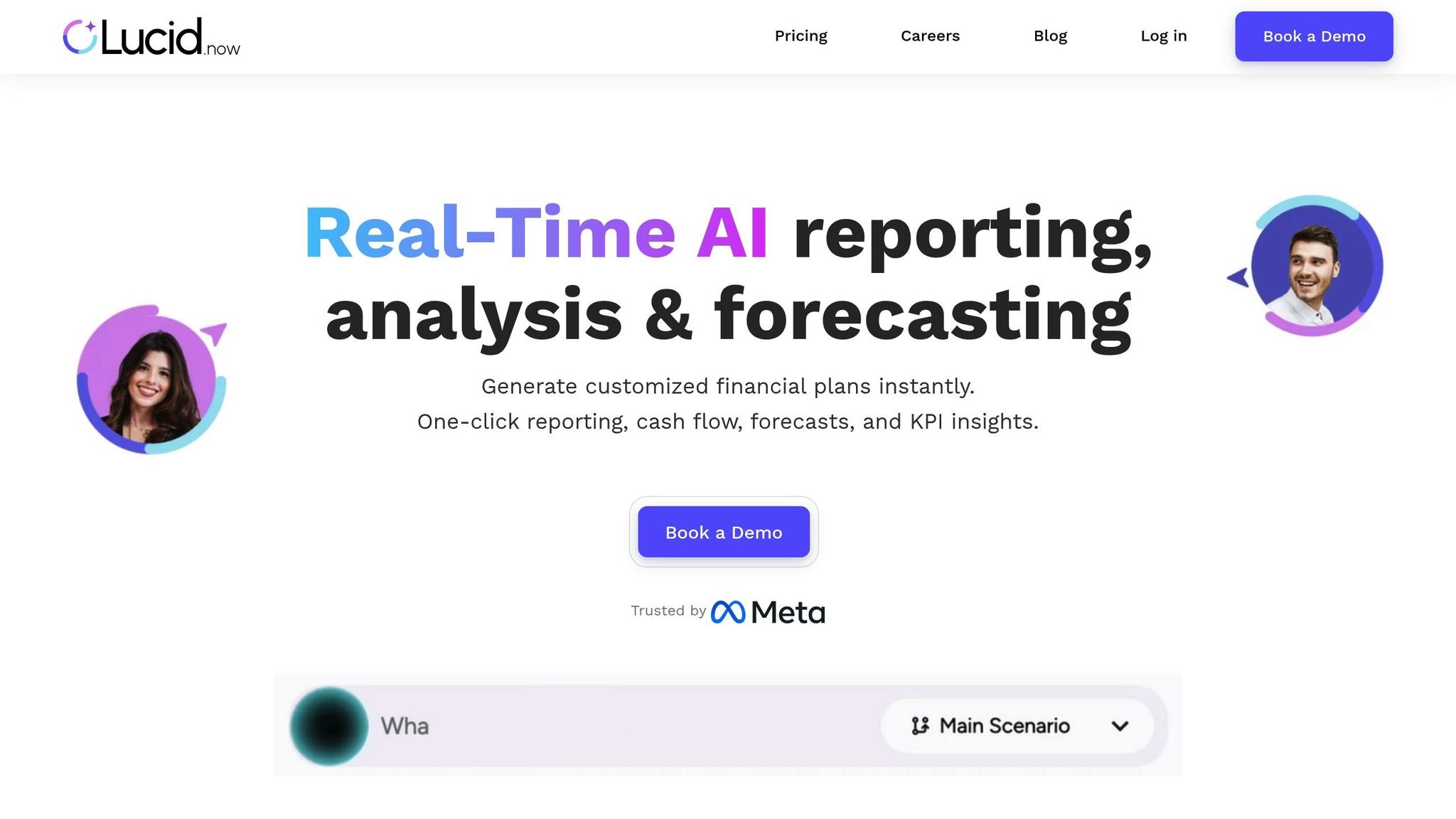AI is transforming ESG reporting by automating data collection, improving accuracy, and offering real-time insights. With 89% of investors prioritizing ESG data and regulatory requirements tightening, businesses are turning to AI tools to streamline processes and meet growing demands.
Key Takeaways:
- Faster Reporting: AI reduces ESG assessment time by up to 75%.
- Improved Accuracy: AI minimizes errors and processes unstructured data like PDFs and emails.
- Customizable Reports: Tailored insights for investors, regulators, and stakeholders.
- Scalability: Handles growing workloads and adapts to new regulations effortlessly.
- Leading Tools: Clarity AI (materiality analysis), Novisto (data management), Lucid Financials (financial integration), Ecometrica (carbon tracking), GreenFi (compliance automation).
Why It Matters:
With ESG-focused investments projected to reach $33.9 trillion by 2026, AI-powered tools are essential for businesses to stay competitive, comply with regulations, and deliver actionable insights.
Start leveraging AI today to save time, improve accuracy, and meet investor expectations.
Using Generative AI for ESG Insights
Key Benefits of Using AI for ESG Reporting
AI has emerged as a game-changer for ESG reporting, addressing the challenges of accuracy, customization, and scalability that have long hindered traditional methods. By automating and streamlining processes, AI not only saves time but also ensures consistency and precision.
Better Data Accuracy and Speed
AI significantly enhances the speed and accuracy of ESG reporting. Tasks that once required hours of manual effort can now be completed in a fraction of the time, with fewer mistakes.
Time-Saving Efficiency: AI can reduce the time needed for ESG assessments to just one hour, compared to the four to six hours typically required for manual processes. This allows teams to shift their focus from repetitive administrative tasks to more strategic activities, like analysis and decision-making.
Neil Robson, Regulatory Compliance Partner for Financial Services at Katten Muchin Rosenman, highlights this advantage: "There are lots of standards and rules out there – and once the software knows how to address each one, it can do so over and over again".
This capability eliminates the inconsistencies often associated with manual workflows.
Fewer Errors: By standardizing data and cross-referencing information, AI minimizes human error. It can process massive datasets quickly, analyzing numerous reports in a short time while maintaining accuracy levels that manual methods struggle to achieve.
AI also tackles the challenge of unstructured data, which accounts for 90% of ESG information and is often scattered across sources like PDFs, emails, and Excel files. Tomas van der Heijden, CEO and Co-founder of Briink, explains:
"The problem is that 90% of that data is unstructured – scattered between sources such as website text, PDFs, Excel files, emails and so on. As a result, a significant amount of that data is not being assessed".
AI consolidates this scattered data into unified systems for easier analysis.
Real-Time Insights: With real-time dashboards, teams can quickly identify and address anomalies. This immediacy provides a level of responsiveness that manual systems can’t match.
In addition to speed and accuracy, AI also customizes ESG data to meet the unique needs of various stakeholders.
Customizable ESG Metrics for Stakeholder Needs
Different stakeholders care about different aspects of ESG data. AI makes it possible to create tailored reports that address these diverse priorities without requiring separate data collection efforts.
Tailored Reporting: With 85–89% of investors factoring ESG data into their decisions, AI platforms can customize reports to align with specific stakeholder interests. For instance, investors may prioritize metrics like carbon footprint reduction, while regulators might focus on compliance with emissions standards.
Given that global sustainable investment has reached $30.3 trillion - a 68% increase since 2014 - the demand for precise, relevant ESG reporting continues to rise.
Dynamic Reporting Systems: AI enables the creation of adaptive systems that go beyond static, periodic reports. These systems provide continuous updates, allowing businesses to respond promptly to stakeholder inquiries and evolving regulatory requirements without starting from scratch.
Framework Adaptability: Generative AI can format ESG reports to meet various reporting standards, such as GRI, SASB, or TCFD. This flexibility ensures that the same underlying data can satisfy the preferences of different stakeholders.
As reporting demands grow, scalability becomes just as critical as customization.
Scalability for Growing Businesses
For companies experiencing growth, traditional ESG reporting methods can quickly become a bottleneck. AI offers the scalability needed to maintain quality while handling increasing workloads.
Handling Larger Workloads: AI-driven systems can scale effortlessly to accommodate more clients or higher data volumes without requiring significant infrastructure changes. This allows consultants and businesses to take on more work without compromising service quality.
Proven Applications: Large corporations have already demonstrated how AI can scale ESG reporting and emissions monitoring.
Regulatory Adaptation: Scalable AI solutions can quickly adjust to new or changing ESG regulations, ensuring compliance without disrupting operations. As regulatory frameworks evolve, this adaptability becomes increasingly valuable.
Financial Impact: The benefits extend beyond compliance. McKinsey and Company found that "at least 5 percent of their organizations' EBIT was attributable to AI in 2021, in line with findings from the previous two years". Cloud-based AI platforms also provide the agility to keep up with shifting business needs and market conditions.
AI Tools for ESG Metrics
As the demand for accurate and thorough sustainability reporting continues to grow, AI-powered ESG tools are stepping up to help businesses meet investor expectations. These platforms tackle a range of challenges, from tracking carbon emissions to ensuring regulatory compliance. Below are some standout tools that showcase how AI is transforming ESG data management.
Clarity AI: Smarter Materiality Analysis

Clarity AI focuses on optimizing investment portfolios by analyzing material ESG factors. Using machine learning, it identifies which ESG metrics are most relevant for specific industries and investment strategies. This helps investors understand how sustainability factors influence portfolio performance.
What sets Clarity AI apart is its ability to adapt materiality assessments based on changes in market conditions or regulations. This dynamic feature allows investment firms to produce highly targeted ESG reports, ensuring they address the most pressing concerns of their stakeholders.
Novisto: Streamlined ESG Data Management

Novisto simplifies ESG reporting by consolidating data from various sources into a single platform. It automates compliance tasks and generates reports that align with global standards like GRI, SASB, and TCFD. By standardizing and validating data across multiple inputs, Novisto helps businesses keep up with shifting regulatory demands without the need for manual intervention.
Lucid Financials: Merging ESG and Financial Insights

Lucid Financials takes ESG reporting a step further by integrating sustainability metrics directly into its financial planning tools. This platform is particularly valuable for startups and small-to-medium businesses, as it combines financial performance data with ESG benchmarks in a single report.
This integration eliminates the need for separate systems, allowing businesses to provide investors with detailed updates that connect sustainability efforts to overall business performance. For growing companies, this approach simplifies reporting while maintaining precision.
Ecometrica: Carbon Tracking Powered by Satellites

Ecometrica uses satellite technology to deliver highly accurate carbon accounting across all three scopes of emissions. The platform automates greenhouse gas reporting for Scopes 1, 2, and 3, offering real-time tracking that surpasses traditional methods.
For example, Aggreko utilized Ecometrica to meet the UK’s mandatory carbon reporting requirements, producing audit-ready environmental reports. The platform’s ability to provide real-time monitoring is a game-changer, allowing companies to assess their environmental impact continuously rather than relying on periodic evaluations.
"Using the platform gives us the confidence to continue to improve and extend our carbon emissions reporting as the Group rolls out its ambitious decarbonization plans globally." – Alison Cole, Group Corporate Affairs, National Express
GreenFi: Automating ESG Compliance

GreenFi specializes in automating ESG compliance and risk monitoring, helping organizations stay ahead of evolving regulations. Its AI-driven tools monitor climate risks and analyze ESG data, reducing reliance on manual oversight.
The platform is currently collaborating with United Overseas Bank (UOB) and other industry partners to automate due diligence processes and improve efficiency through custom ESG workflows. GreenFi’s ability to integrate seamlessly with existing business systems simplifies data collection and reporting, making it an essential tool for companies aiming to demonstrate consistent ESG performance.
With sustainable investments projected to exceed $40 trillion by 2030, tools like GreenFi are becoming indispensable for businesses looking to meet investor and regulatory expectations while maintaining operational efficiency.
Technical Insights: How AI Powers ESG Reporting
Artificial intelligence is transforming ESG reporting by automating the collection, processing, and analysis of data, making the process faster and more reliable.
AI-Driven ESG Data Pipelines
AI systems streamline ESG reporting by setting up automated pipelines that gather data from diverse sources such as internal systems, regulatory filings, and third-party reports. These pipelines pull information from tools like accounting software, HR platforms, government databases, sustainability reports, and even news articles. This automation eliminates the tedious manual effort traditionally required to compile ESG information.
Natural language processing (NLP) plays a key role in extracting ESG data from unstructured sources. For instance, an AI tool might scan hundreds of supplier sustainability reports to pinpoint and classify carbon emissions data according to specific reporting frameworks. Machine learning algorithms then analyze both structured and unstructured data, identifying patterns and flagging inconsistencies.
Take EnerSys as an example. The company uses ChatGPT Enterprise to analyze sustainability metrics, including emissions, waste, and travel data. This approach has enabled their team to uncover actionable insights far more quickly than manual methods. The system also automates responses to customer data requests, generates internal reports, and assists the sustainability team in reviewing Climate Disclosure Project (CDP) questionnaire responses to spot data gaps.
Once this data is collected, AI ensures its accuracy through rigorous validation processes.
Data Validation and Accuracy
AI doesn't just gather ESG data - it ensures its accuracy through automated validation processes that go beyond traditional manual reviews. These systems cross-check data from multiple sources, compare it against established benchmarks, and flag anomalies for further investigation. With anomaly detection algorithms, AI can highlight unexpected changes in reported data, ensuring nothing is overlooked.
Additionally, AI aligns metrics across different ESG frameworks such as GRI, SASB, and TCFD, ensuring consistency in reporting. It can even cross-reference self-reported data with external sources to verify its accuracy and detect potential greenwashing.
| Validation Feature | Traditional Method | AI-Powered Method |
|---|---|---|
| Data Collection | Manual and error-prone | Automated and efficient |
| Anomaly Detection | Subjective manual review | Objective and automated |
| Cross-Referencing | Limited and time-consuming | Comprehensive, real-time |
| Processing Speed | Slow and labor-intensive | Fast and real-time |
The benefits are clear. As apexanalytix explains:
"Accuracy and reliability are critical when it comes to ESG reporting. AI excels in this area by automating data validation processes".
For instance, AI can automatically process invoices and receipts for carbon accounting, identifying relevant emission factors, assigning fuel types, and calculating CO₂ values - all without manual input. This ability to handle vast datasets allows ESG consultants to analyze thousands of reports efficiently, maintaining high-quality service while meeting growing reporting demands.
sbb-itb-17e8ec9
Future Trends in AI and ESG Metrics
AI is reshaping ESG reporting at an incredible pace, fueled by evolving regulations and technological advancements. Soon, real-time ESG monitoring and predictive risk management will become the norm. These developments promise not only improved compliance but also deeper insights into investor performance.
New Standards for AI-Processed ESG Data
Regulatory changes are redefining how companies approach AI-driven ESG reporting. One of the most impactful changes is the EU's Corporate Sustainability Reporting Directive (CSRD), which requires companies operating in the EU to provide detailed ESG disclosures. This includes reporting on how sustainability issues influence their business and how their operations affect people and the environment.
By 2026, all ESG data under CSRD must be digitally tagged, making it easier to compare and access. This shift makes AI tools indispensable, as manual processes simply can’t manage the scale and complexity of these requirements.
Interestingly, regulations are also evolving to offer more flexibility. For example, in February 2025, the European Commission introduced the Omnibus Simplification Package, which is set for review and voting in April 2025. If approved, this package will reduce the number of companies covered by CSRD from 50,000 to approximately 10,000, while also easing some reporting requirements.
On a global scale, standards like IFRS S1 and S2 are pushing for a unified ESG reporting baseline. Additionally, supply chain oversight regulations, such as the Corporate Sustainability Due Diligence Directive (CS3D) and the Regulation on Deforestation-free Products (EUDR), are driving demand for advanced AI tools to collect and analyze data effectively.
"ESG readiness is no longer a matter of choice but a necessity." - Vanessa Müller, EY Luxembourg ESG Services and Consulting Banking & Capital Markets Lead
In response, companies are turning to digital tools and AI-powered software to automate data collection, enhance accuracy, and deliver real-time insights into regulatory risks. The push for standardized reporting formats and increased scrutiny of ESG claims has created a growing need for transparent, reliable ESG data. These frameworks also set the stage for the predictive analytics solutions discussed below.
Predictive Analytics in ESG Risk Management
The adoption of predictive analytics is revolutionizing ESG risk management. By leveraging historical data, machine learning, and statistical models, companies can now anticipate future ESG challenges and trends.
A Deloitte report highlights that 70% of global wealth management firms have embraced this shift, recognizing the value of blending human expertise with predictive intelligence.
For example, a manufacturing company might analyze past energy usage to predict future consumption and test strategies like adjusting production schedules or upgrading machinery to reduce its carbon footprint. Studies show that simulation-based approaches can cut total installed costs by at least 5% when comparing similar assets. These predictive tools give companies the ability to offer forward-looking ESG insights, moving beyond just historical data.
Another major trend is the transition from annual sustainability reports to real-time monitoring. This shift enables businesses to respond swiftly to emerging risks and opportunities while equipping investors with up-to-date information for better decision-making.
Looking ahead, ESG-focused institutional investments are expected to hit $33.9 trillion by 2026. This surge will create massive demand for advanced AI solutions capable of scaling analysis and reporting to meet these needs.
"At its essence, ESG is a toolkit for companies to identify material risks and opportunities. Being smart about maximizing opportunity and minimizing risk will never go out of style." - Miriam Wrobel, Senior Managing Director of the ESG practice, FTI Consulting
Conclusion: Using AI for ESG Success
AI-driven ESG reporting is no longer a luxury - it's a necessity. With 89% of investors factoring ESG considerations into their decisions, businesses that neglect to embrace these tools risk falling behind and losing vital access to funding.
The advantages are clear. AI slashes the time it takes to process ESG data, turning weeks of manual effort into minutes of automated analysis. This efficiency is critical as spending on ESG business services is projected to jump from $37.7 billion in 2023 to nearly $65 billion by 2027.
For startups and small-to-medium businesses, the benefits go beyond compliance. AI helps detect patterns and anomalies, enabling quicker corrective actions. It also automates time-consuming tasks like benchmarking and generating reports, giving teams more bandwidth to focus on strategy.
Take Lucid Financials as an example - it showcases how AI can seamlessly integrate ESG metrics into financial planning. By combining real-time insights with industry benchmarks, businesses can present a cohesive narrative that ties sustainability directly to performance. This reflects the growing trend toward real-time, automated ESG analysis.
To get started, focus on the ESG metrics that matter most to your business. Look for AI tools that offer both flexibility and scalability. Specialized platforms can provide the tailored insights you need for accurate and impactful reporting.
FAQs
How does AI make ESG reporting faster and more accurate than traditional methods?
How AI Transforms ESG Reporting
AI is revolutionizing ESG reporting by streamlining how data is collected, analyzed, and validated. It drastically cuts down the time needed to process huge volumes of information from multiple sources, achieving in moments what might take days through manual methods. This efficiency ensures reports are prepared and delivered on schedule.
But speed isn’t the only advantage. AI also boosts accuracy by cross-referencing data from various inputs, spotting inconsistencies, and aligning everything with established reporting standards. By minimizing human error and ensuring compliance, AI has become a critical tool for generating dependable and timely ESG reports.
How do AI tools improve ESG metric reporting for different stakeholders through customization and scalability?
AI tools have transformed how organizations handle ESG metric reporting by making the process more adaptable and efficient. These tools automate the collection and analysis of data, enabling businesses to create ESG reports that highlight the metrics most relevant to specific audiences - whether it's investors, regulators, or customers. This targeted approach ensures stakeholders receive insights that are both meaningful and actionable.
Another key advantage is AI's ability to process vast amounts of data in real time. As businesses expand, AI helps them manage and scale their ESG initiatives, seamlessly integrating data from multiple sources. This ensures accurate tracking and compliance, even across intricate supply chains and shifting regulatory landscapes. Combining flexibility with the power to handle complex data, AI has become a vital tool for producing accurate and timely ESG reports in today’s fast-paced business world.
How do AI tools help businesses stay compliant with ESG standards like GRI, SASB, and TCFD?
AI tools make managing ESG compliance much easier by automating tasks like data collection, analysis, and reporting. Many of these tools come preloaded with frameworks that align with standards such as GRI, SASB, and TCFD, helping businesses create accurate reports that meet today’s regulatory demands.
What’s more, these platforms are built to keep up with changing regulations. They provide real-time updates and insights, allowing companies to monitor their ESG performance, adapt to new compliance requirements, and stay transparent in their sustainability efforts.


